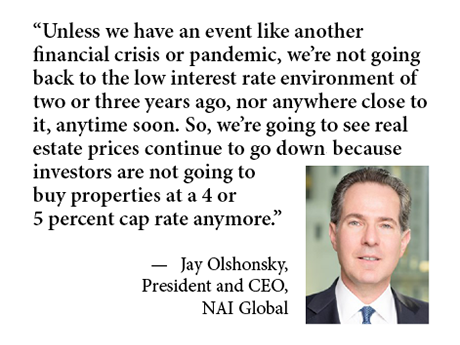If NAI Global president and CEO Jay Olshonsky had to use one word to sum up the 2023 commercial real estate market, it would be “inactive.” The interest rate-fueled bid-ask spread stifled investment sales of all property types, and in the office sector especially, tenants avoided making any space decisions if they didn’t have to.
One month into 2024, not much has changed. From an investment sales perspective, Olshonsky still sees properties offered at capitalization rates between 4 and 5 percent while interest rates are 6 percent or higher, which is prolonging the disconnect between buyers and sellers. Meanwhile, robust job creation well beyond today’s levels is needed to create the leasing demand that will reverse the office sector’s troubles in the new era of hybrid work. But that’s not likely to happen in 2024 as the tech sector, in particular, continues to lay off workers.
“I’ve been in the real estate business a long time, and this is a cycle unlike most others,” says Olshonsky. “The biggest problem we have right now is mainly record-high office vacancy just about everywhere — certainly in the large cities — which we’ve never really seen before. On the investment side, lenders cannot pretend and extend forever — they’re going to have to deal with properties that have lost substantial value. I think we’ll see increased transactions this year fueled by distress, but not necessarily more normal investment activity.”
Mixed Market
Fundamentally, most property types fared better than the office sector in 2023 and should continue to perform reasonably well this year, Olshonsky observes. Retail has recovered from the bulk of its issues leading up to and during the pandemic lockdowns, e-commerce continues to drive industrial real estate demand and apartments are benefitting from a broad chronic housing shortage.
Still, weakness is creeping in on the margins across many property types, as evidenced by rising potential distress tracked by MSCI Real Assets, a commercial real estate researcher. Some apartment investors who tapped low-cost bridge loans to overpay for properties are facing reduced cash flows in an environment marked by higher rates and supply, Olshonsky points out. More specialized asset classes like hotels are also experiencing distress — some have sold for 50 percent less than the last sales price, he shares.
“A lot of what happens this year with distress will be very location driven,” Olshonsky declares.
The age and functionality of buildings will also influence distress, particularly in the office category, he adds. Some offices have sold for 20 cents on the dollar versus the last sale, he says.
On the bright side, a flight to quality is helping to keep Class A office vacancy relatively low compared to Class B and C space. The overall tenor of the market is providing tenants with leverage, as well.
“When companies have leases ending or they need space, they’re willing to move into a better building with better amenities because they want to create the best environment for their employees,” Olshonsky explains. “If you’re in a market that has a 20 percent office vacancy or higher, it could be the opportunity of a lifetime to make a deal, whether it’s in a Class A, B or C property.”
Acclimating to Interest Rates
The dovish remarks by Federal Reserve Chair Jerome Powell following what Wall Street deemed a favorable inflation report in December primed the commercial real estate market for rate cuts early in 2024. The next month’s hotter-than-expected inflation report tempered those expectations. Regardless of the Fed’s ultimate actions, Olshonsky believes that the market needs to adjust to a “higher-for-longer” rate environment.
If the central bank does indeed cut the federal funds rate in 2024, it is likely to do so by only 25 to 75 basis points, he notes. Perhaps that will decrease benchmark rates by a similar amount, he says, but the rates will not fall as dramatically as they rose over a roughly 18-month period beginning in early 2022.
What’s more, Olshonsky continues, the Fed’s decision to lower interest rates does not guarantee that lenders will drop the cost of capital significantly. That will be determined by the risk profile of the property, location and sponsor, as well as the state of the economy. And for the first time in more than a decade, he remarks, U.S. Treasuries are offering competitive yields of around 5 percent with much lower risk than real estate.
“Unless we have an event like another financial crisis or pandemic, we’re not going back to the low interest rate environment of two or three years ago, nor anywhere close to it, anytime soon,” Olshonsky states. “So, we’re going to see real estate prices continue to go down because investors are not going to buy properties at a 4 or 5 percent cap rate anymore.”
— By Joe Gose. This article was written in conjunction with NAI Global, a content partner of REBusinessOnline. For more articles from and news about NAI Global, click here.


